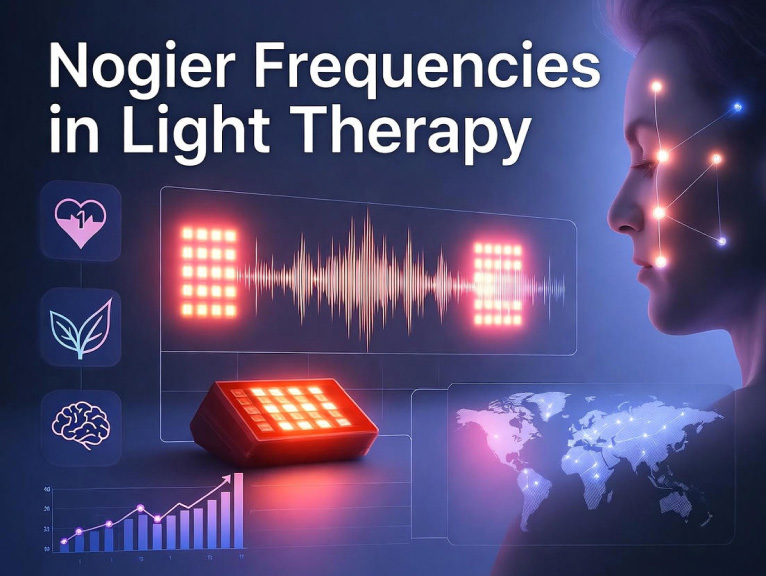
20 Years of Producing the Highest Quality, Most Reliable, and Effective LED mask.
Discover how Nogier frequencies combined with light therapy promote healing, balance, and tissue regeneration. Explore the science, benefits, historical context, practical applications, and tips for using frequency-modulated LED devices

Frequency Modulation Nogier Light Therapy represents a fusion of ancient healing principles with modern photobiomodulation technology. This approach uses modulated light frequencies to stimulate the body's natural regenerative processes, promoting balance and healing. Many physiological processes align with light cycles, and specialized molecules like cytochrome c oxidase in mitochondria absorb red and near-infrared light, triggering reactions that enhance cellular function. Developed by Dr. Paul Nogier, a French neurologist who pioneered auriculotherapy, these frequencies map to specific tissue types and are applied via LED devices for non-invasive therapy. In 2025, amid growing interest in alternative medicine, Nogier therapy is gaining traction for its potential in pain relief, tissue repair, and immune support. This guide explores its mechanisms, benefits, applications, and practical use, drawing on scientific insights and studies.
Therapeutic light instruments can be pulsed at various frequencies, coupling light with compatible modulations to stimulate regenerative processes. This modulation enhances therapeutic outcomes by aligning with the body's natural rhythms. At the cellular level, light absorption by cytochrome c oxidase initiates redox reactions, influencing mitochondrial function and secondary pathways like improved wound healing, blood flow, and immunomodulation. Nogier frequencies, identified through auriculotherapy, are programmed into LED devices emitting red (610–670 nm) and near-infrared (830–870 nm) light. The light is directed at acupuncture points or affected areas, where lower frequencies encourage cellular activity and higher ones provide pain relief. Modern devices run preset programs that sequence frequencies automatically, shutting off after sessions.
Dr. Paul Nogier discovered these frequencies in the 1970s while mapping ear acupuncture points. He identified seven primary frequencies corresponding to embryonic tissue layers (ectoderm, mesoderm, endoderm), using them to restore energetic balance. Initially applied via acupuncture, they were later adapted to light therapy for non-invasive delivery. Early studies showed efficacy in pain management and regeneration, influencing bioresonance therapies like those by Dr. Reinhold Voll. In 2025, advancements in LED tech have made Nogier therapy more accessible, with devices integrating these frequencies for home and clinical use.
Light therapy acts as an antioxidant, protecting cells from free radicals and modulating proteins against degeneration. It increases red blood cell resistance, regulates inflammation, and stimulates tissue regeneration. Nogier frequencies add specificity: lower ones (e.g., 73 Hz) boost cellular activity, while higher (e.g., 4,672 Hz) provide analgesic effects by influencing nerve conduction and cytokine release. Combined with light, they enhance ATP production, improve microcirculation, and support lymphatic function, aiding homeostasis.
The seven Nogier frequencies are:
Lower frequencies (A, B, F) for regeneration; higher (C-E) for pain; G, E for analgesia; C, D, G for relaxation.
Based on research and anecdotal evidence, Nogier light therapy offers several potential advantages for healing and balance:
In 2025, Nogier therapy is applied for musculoskeletal pain, edema, sinusitis, insomnia, and autonomic nervous system disorders. Research includes Douris et al. (2006) on phototherapy for muscle soreness, showing significant reductions; Ramagole's pilot study on sports injuries with improved outcomes; and Junior et al. on LED therapy for pre-exercise benefits. Dosimetry studies emphasize light thresholds for effects, while emerging research explores bioresonance for chronic conditions like fibromyalgia.
Consult a practitioner to determine suitability and specific frequencies for your condition. Acquire a programmable LED device (e.g., with red/NIR wavelengths, costing $100-$500). Select frequencies based on symptoms (e.g., Frequency E for pain, F for regeneration). Apply the device to acupuncture points or affected areas for 10-20 minutes per session, 3-5 times weekly. Track progress with a journal noting pain levels or energy. Combine with healthy lifestyle for better results; discontinue if irritation occurs.
Integrate Nogier frequencies into auriculotherapy or photobiomodulation protocols using multi-frequency devices. Assess patients with tools like pulse diagnosis to select appropriate frequencies. Customize sessions: start with lower frequencies for regeneration, higher for pain relief. Training via courses ($500-$2,000) enhances expertise. Charge $50-$150 per session; ROI from repeat clients and expanded services. Ensure sterile practices and monitor outcomes for evidence-based adjustments.
Nogier light therapy is generally safe when used correctly, with no known serious side effects. Avoid overuse to prevent potential skin irritation or eye strain; use protective eyewear if needed. Not suitable for photosensitive conditions or during pregnancy without consultation. Follow device guidelines and consult a healthcare professional before starting.
Nogier frequency modulation in light therapy offers a powerful, non-invasive tool for promoting healing and balance. With growing research support, it's an exciting option for patients and practitioners alike. Consult experts to explore its potential for your health needs.
